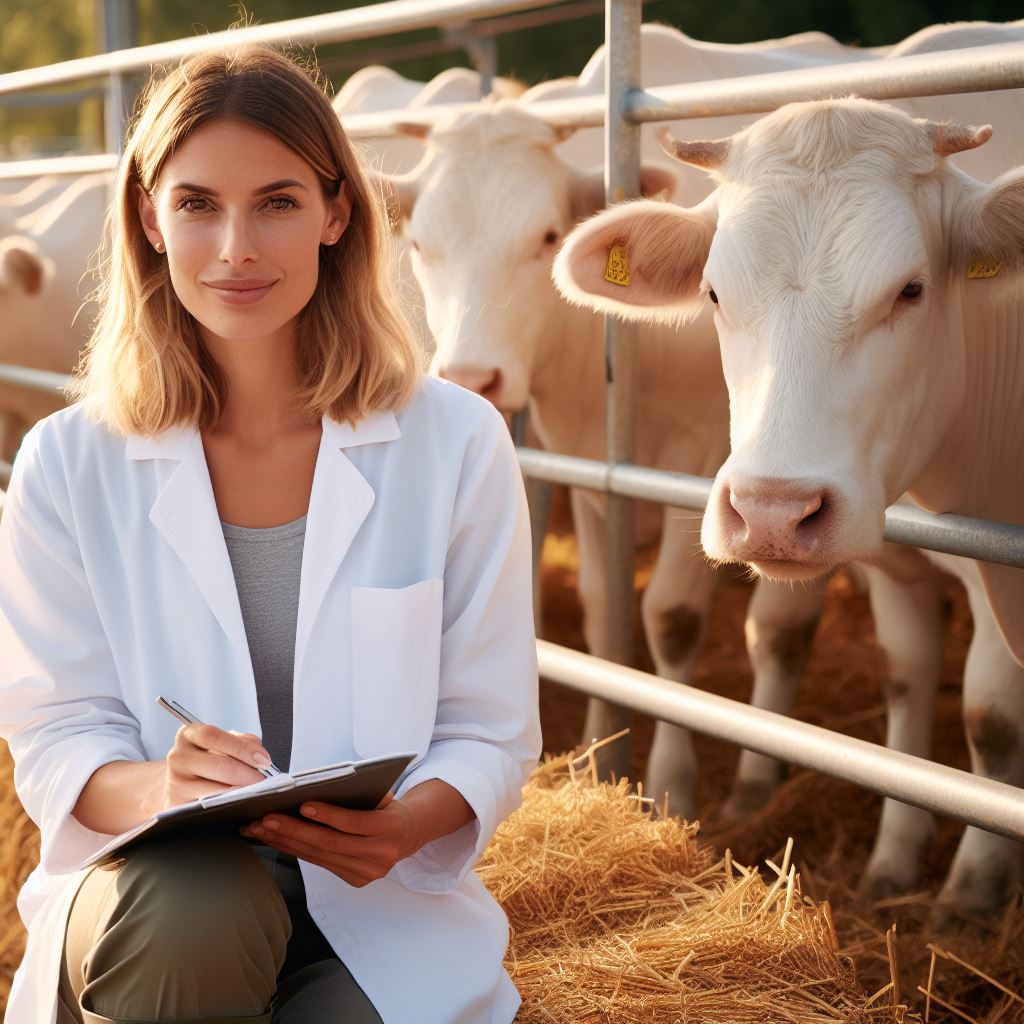Introduction
Modern US animal breeders face numerous challenges in their efforts to maintain and improve livestock genetics.
Role of animal breeders in the US
Animal breeders play a crucial role in the US agricultural industry, focusing on breeding animals for desired traits such as quality, productivity, and disease resistance.
The challenges faced by modern US animal breeders
- Declining genetic diversity: Breeders must combat reduced genetic variation due to the extensive use of a few popular animals, which can lead to increased susceptibility to diseases.
- Health and disease management: Breeders continually face the challenge of keeping livestock healthy and preventing the spread of diseases through careful breeding practices and regular health screenings.
- Changing market demands: Breeders must constantly adapt to shifting consumer preferences and market demands, which often require them to modify breeding strategies and develop new traits in their animals.
- Economic pressures: The rising costs of feed, equipment, and land make it difficult for breeders to maintain profitability while maintaining high-quality breeding programs.
- Regulatory restrictions: Breeders must navigate a complex web of regulations regarding animal welfare, genetic modification, and animal transportation, which may vary across states and regions.
- Climate change: Breeders face the challenge of adapting their breeding practices to the changing climate, including addressing the increasing frequency of extreme weather events and their potential impact on animal health and productivity.
Despite these challenges, modern US animal breeders remain committed to their crucial role in ensuring the sustainability and success of the agricultural industry.
Through innovation and continuous adaptation, they strive to overcome these obstacles and deliver superior livestock genetics.
Changing consumer demands
- Consumers are becoming increasingly concerned about the origin and quality of animal products.
- They are looking for products that are free from chemicals, hormones, and antibiotics.
- There is a growing trend towards natural and organic products, which has created challenges for animal breeders.
- Breeders must now ensure that their practices align with the demands of the market.
- They may need to adjust their breeding techniques and practices to meet consumer preferences.
The shift towards organic and sustainable products
- Organic and sustainable products have gained popularity due to their perceived health and environmental benefits.
- Consumers are willing to pay a premium for products that are produced using environmentally-friendly methods.
- Animal breeders are facing the challenge of transitioning their operations to meet organic and sustainable standards.
- This may involve changing their feed, housing, and medical practices to comply with strict guidelines.
Need for breeders to adapt to the market demands
- In order to stay competitive, animal breeders must stay informed about market trends and consumer preferences.
- They must be willing to invest in new technologies and research to meet changing demands.
- Breeders may need to develop new breeds or crossbreeds that are better suited to the demands of the market.
- They may also need to establish partnerships or collaborations with other stakeholders in the industry.
Challenges associated with changing breeding techniques and practices
- Implementing new breeding techniques and practices can be costly and time-consuming.
- Breeders may face resistance from traditionalists who are resistant to change.
- There may be a learning curve associated with adopting new techniques and practices.
- Breeders may need to invest in training and education to ensure they can successfully implement new methods.
- There is also the risk that changes in breeding techniques may cause unintended consequences or negative effects on animal health and welfare.
Over all, modern US animal breeders face numerous challenges in meeting changing consumer demands.
The shift towards organic and sustainable products, coupled with the need for breeders to adapt to market demands, requires them to adjust their breeding techniques and practices.
While these challenges may be daunting, breeders who are flexible and willing to invest in research, technology, and education can navigate these changes and thrive in the evolving market.
Genetic diversity and inbreeding
Importance of genetic diversity in animal population
Genetic diversity plays a crucial role in animal populations as it ensures their long-term survival.
Having a diverse gene pool allows animals to adapt to changing environmental conditions and resist diseases.
Moreover, genetic diversity enhances the overall fitness and reproductive success of the population.
Risks of inbreeding and loss of genetic diversity
Unfortunately, modern US animal breeders face challenges in maintaining genetic diversity due to several factors.
Inbreeding is one major risk that threatens the genetic diversity of animal populations.
When closely related individuals mate, it increases the chances of passing on harmful genetic traits.
This can lead to reduced fertility, weakened immune systems, and an overall decline in the health of the population.
Loss of genetic diversity also diminishes the gene pool, making animals more vulnerable to diseases and environmental stresses.
Without sufficient genetic diversity, animals may struggle to adapt and survive in changing conditions.
Additionally, inbreeding depression can occur, affecting the future generations of animals.
Challenges of maintaining genetics diversity while meeting market demands
As the number of unrelated individuals decreases, it becomes increasingly challenging for breeders to find suitable mates.
Meeting market demands adds further complexity to maintaining genetic diversity in animal populations.
Breeders often face pressure to produce animals with specific traits that are preferred by consumers.
Transform Your Career Today
Unlock a personalized career strategy that drives real results. Get tailored advice and a roadmap designed just for you.
Start NowThis demand for certain characteristics may lead to a narrow focus on a few high-demand traits, resulting in reduced genetic variation.
Furthermore, breeders may opt for popular and commercially successful breeds, neglecting less common ones.
This can lead to the loss of unique genetic traits and further reduce overall genetic diversity.
To address these challenges, breeders must adopt strategies that prioritize genetic diversity in their breeding programs.
Implementing breeding programs that include outcrossing with genetically distant individuals can help introduce fresh genetic material.
Monitoring and managing mating pairs based on their genetic relatedness can also prevent excessive inbreeding.
Additionally, breeders can collaborate with other breeders and organizations to exchange genetic material and diversify their gene pools.
Education and awareness campaigns are essential to promote the importance of genetic diversity and its benefits.
By emphasizing the significance of maintaining genetic diversity, breeders can garner support and cooperation from stakeholders.
In fact, genetic diversity is vital for the long-term survival and health of animal populations.
Breeders must navigate numerous challenges to ensure genetic diversity while meeting market demands.
By adopting appropriate strategies and fostering collaboration, breeders can overcome these challenges and contribute to the preservation of genetic diversity.
Regulations and compliance
- The regulatory environment for animal breeders can be challenging and complex.
- Breeders must navigate various regulations and standards set by government agencies.
- Non-compliance with these regulations can result in fines, penalties, or even the shutdown of operations.
- Breeders need to stay updated with changing regulations and ensure compliance at all times.
- Complying with regulations requires breeders to invest extra time, effort, and resources.
Overview of the regulatory environment for animal breeders
- Animal breeders in the US are subject to regulations at federal, state, and local levels.
- Government agencies like the USDA, FDA, and EPA set rules to protect animal welfare and ensure food safety.
- Regulations cover aspects such as breeding practices, animal housing, record-keeping, and genetic testing.
- Animal breeders must obtain permits, licenses, and certifications to operate legally.
- Inspections by government authorities are conducted to assess compliance with regulations.
Challenges in complying with various regulations and standards
- Meeting the specific requirements of multiple regulations can be demanding for breeders.
- Regulations may differ between states or even within different counties, adding complexity.
- Breeders must document and maintain records to demonstrate compliance with each regulation.
- Understanding technical language and legal jargon within regulations can be overwhelming for some breeders.
- Compliance may involve additional costs such as investing in infrastructure upgrades or hiring compliance personnel.
Impact of compliance on breeding practices and overall operations
- Compliance with regulations can lead to improved breeding practices and higher animal welfare standards.
- Breeders may need to modify their breeding processes to align with regulatory requirements.
- Implementing proper record-keeping systems helps breeders track and improve their breeding operations.
- Stringent regulations may result in a decrease in the number of breeders or consolidation within the industry.
- Compliance fosters consumer trust, as it ensures the production of safe and healthy animals.
Generally, modern US animal breeders face numerous challenges in navigating the regulatory environment.
Complying with various regulations and standards can be demanding, requiring significant effort, resources, and understanding.
However, adherence to these regulations not only ensures the welfare of animals but also improves breeding practices and builds consumer trust.
Read: Financial Prospects of Animal Breeding in the USA
Ethical Considerations in Modern US Animal Breeding
Animal breeding in the modern United States faces numerous challenges, particularly in terms of ethical considerations and the growing concern for animal welfare.
Breeders have the difficult task of ensuring profitability while also meeting ethical standards and balancing the needs of the animals with market demands and profit margins.
Growing Concern for Animal Welfare in Breeding Practices
Over the years, there has been a significant increase in public awareness and concern for the welfare of animals involved in breeding practices.
Society’s views on animal rights and ethical treatment have changed, placing a greater emphasis on ensuring the well-being of animals.
Transform Your Career Today
Unlock a personalized career strategy that drives real results. Get tailored advice and a roadmap designed just for you.
Start NowConsumers are increasingly demanding products that come from ethically bred animals, meaning animals that have been treated humanely throughout their lives.
This shift in consumer preferences poses a challenge for breeders who may have to make significant changes to their practices to meet these new standards.
Challenges in Meeting Ethical Standards while Ensuring Profitability
While breeders strive to meet ethical standards, they also face the continuous challenge of maintaining profitability.
Ethical breeding practices often require additional resources, such as providing better living conditions, proper nutrition, and healthcare for the animals.
Investing in these ethical practices may lead to increased expenses, which can reduce profit margins.
Breeders must find a balance between ethical considerations and financial viability to sustain their operations and remain competitive in the market.
Balancing the Needs of the Animals with Market Demands and Profit Margins
Another challenge faced by modern animal breeders is finding a balance between meeting the needs of the animals and satisfying market demands.
Breeders must consider market trends and consumer preferences while ensuring the welfare of the animals.
For example, there may be a rising demand for specific traits or characteristics in certain breeds.
This demand may lead breeders to employ selective breeding practices that could compromise the long-term well-being of the animals.
Breeders must carefully navigate these market pressures, making decisions that prioritize the welfare of the animals without sacrificing profitability.
Implementing Ethical Standards and Overcoming Challenges
To address the challenges faced by modern US animal breeders in meeting ethical standards, several steps can be taken.
- Breeders should prioritize animal welfare by providing the necessary resources for their well-being.
- Investing in research and innovation can lead to more sustainable and ethical breeding practices.
- Collaboration with animal welfare organizations can provide guidance and support in meeting ethical standards.
- Education and awareness campaigns can help consumers understand the importance of ethical breeding and make informed choices.
By implementing these measures, breeders can demonstrate their commitment to ethical practices, address growing concerns for animal welfare, and ensure long-term profitability.
This will not only benefit the animals but also contribute to a more sustainable and responsible breeding industry in the United States.
In essence, modern US animal breeders face numerous challenges in meeting ethical considerations.
The growing concern for animal welfare, meeting ethical standards while ensuring profitability, and balancing the needs of the animals with market demands are complex hurdles to overcome.
However, by prioritizing animal welfare, investing in research, fostering collaboration, and promoting consumer education.
Breeders can navigate these challenges and contribute to a more ethical and sustainable future for animal breeding in the United States.
Read: Ethical Practices for Animal Breeders: US Standards

Technology and Innovation
- Technology has revolutionized modern animal breeding practices, enhancing efficiency and precision.
- New technologies have allowed breeders to collect and analyze vast amounts of data.
- However, adopting and implementing new technologies present significant challenges for modern breeders.
- High costs associated with acquiring and maintaining advanced breeding technologies can be prohibitive.
- Additionally, breeders must continuously invest in training to understand and effectively employ these technologies.
The Role of Technology in Modern Animal Breeding Practices
- Modern breeders heavily rely on technology to facilitate breeding decisions.
- Genetic testing and advanced imaging techniques help identify desirable traits in animals.
- Computer modeling and data analysis contribute to breeding programs aimed at improving animal productivity.
- Artificial insemination and embryo transfer techniques have become commonplace in modern breeding operations.
- Technology plays a crucial role in maintaining detailed breeding records for efficient breeding programs.
Challenges in Adopting and Implementing New Technologies
- Many breeders struggle to keep up with the rapid pace of technological advancements.
- Acquiring the necessary infrastructure and specialized equipment can be financially burdensome for breeders.
- Implementing new technologies also requires breeders to update their knowledge and skill set.
- Resistance to change among breeders may hinder the adoption of new technologies within the industry.
- Furthermore, integrating different technologies into existing breeding systems can be complex and time-consuming.
The Impact of Automation and Genetic Engineering on Breeding Operations
- Automation has improved efficiency and reduced labor costs in breeding operations.
- Automated feeding and milking systems ensure consistent care and productivity in livestock.
- Genetic engineering techniques allow breeders to enhance desirable traits in animals.
- However, the use of genetic engineering also raises ethical concerns and public perception issues.
- Breeders face the challenge of balancing the potential benefits of genetic engineering with its potential drawbacks.
Therefore, technology plays a pivotal role in modern animal breeding practices.
While it offers numerous benefits, breeders encounter various challenges in adopting and implementing new technologies.
Transform Your Career Today
Unlock a personalized career strategy that drives real results. Get tailored advice and a roadmap designed just for you.
Start NowThe impact of automation and genetic engineering also presents breeders with ethical considerations.
Overcoming these challenges requires continuous learning, financial investments, and careful consideration of the long-term effects on breeding operations.
Read: Day in the Life: Following a US Animal Breeder
Economic factors
Animal breeders in the modern US face numerous economic challenges that affect their businesses.
These challenges include understanding the financial aspects of the industry, dealing with fluctuations in input costs, market prices.
And consumer demand, and developing strategies to overcome these challenges and remain competitive in the market.
Understanding the financial challenges faced by animal breeders
One of the primary economic challenges faced by modern US animal breeders is understanding the financial aspects of their industry.
Breeders need to be knowledgeable about various financial components, such as production costs, revenue streams, and profitability metrics.
Without a clear understanding of these factors, breeders may struggle to make informed financial decisions for their businesses.
Fluctuations in input costs, market prices, and consumer demand
Another significant economic challenge for animal breeders is the unpredictable fluctuations in input costs, market prices, and consumer demand.
Breeders often rely on external factors, such as feed prices, healthcare expenses, and labor costs, which can vary greatly over time.
Additionally, market prices for animal products may fluctuate due to supply and demand dynamics, trade policies, or global economic conditions.
Breeders must also stay attuned to changes in consumer demand, such as shifts towards organic or ethically sourced products.
Strategies to overcome economic challenges and remain competitive
To overcome the economic challenges they face and remain competitive, modern US animal breeders can implement various strategies:
- Implement efficient production practices to reduce costs and increase profitability.
- Invest in technology and automation to streamline operations and enhance productivity.
- Diversify revenue streams by exploring alternative animal products or by-products.
- Monitor market trends and consumer preferences to adapt breeding practices accordingly.
- Collaborate with other breeders or industry stakeholders to achieve economies of scale and negotiate better prices for inputs or products.
- Develop strong marketing and branding strategies to differentiate products and attract customers.
- Continuously educate themselves about financial management and seek professional advice when needed.
- Explore government assistance programs, grants, or subsidies that can support breeders during challenging times.
- Establish long-term relationships with suppliers and buyers to ensure stability and smoother operations.
- Network with other breeders and industry associations to share knowledge and learn from each other’s experiences.
Most importantly, modern US animal breeders face economic challenges that require a proactive approach and effective strategies to overcome.
By understanding the financial intricacies of their industry, adapting to fluctuations in input costs, market prices.
And consumer demand, and implementing various strategies, breeders can navigate these challenges and remain competitive in the evolving market.
Read: US Breeding Regulations: What New Breeders Must Know
Conclusion
We discussed the various challenges faced by modern US animal breeders.
We highlighted the importance of addressing these challenges to ensure sustainability and success in the industry.
It is crucial for breeders to seek support and collaborate with others to overcome these challenges.
By working together, breeders can find innovative solutions and strategies to tackle issues such as genetic diversity, animal welfare, and market demand.
Transform Your Career Today
Unlock a personalized career strategy that drives real results. Get tailored advice and a roadmap designed just for you.
Start NowThrough collaboration, breeders can exchange knowledge, resources, and experiences, which will ultimately benefit the entire breeding community.
Addressing these challenges is essential not only for the breeders but also for the maintenance and improvement of animal breeding practices in the US.
It will contribute to the overall success and sustainability of the industry, ensuring that breeders can continue to meet the needs and demands of consumers effectively.
Therefore, it is strongly encouraged that modern US animal breeders actively seek support, foster collaborations, and actively participate in finding solutions.
Together, they can overcome these challenges and thrive in the ever-evolving world of animal breeding.
[E-Books for Sale]
The Big Book of 500 High-Paying Jobs in America: Unlock Your Earning Potential
$19.99 • 500 High-Paying Jobs • 330 pages
Explore 500 high-paying jobs in America and learn how to boost your career, earn more, and achieve success!
See All 500 High-Paying Jobs of this E-Book
1001 Professions Without a Degree: High-Paying American Jobs You Can Start Now
$19.99 • 1001 Professions Without a Degree • 174 pages
Discover 1001 high-paying jobs without a degree! Unlock career tips, skills, and success strategies for just $19.99!




